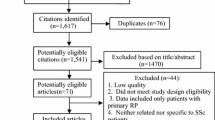Abstract
Major cutaneous vascular complications of systemic sclerosis (SSc) are secondary Raynaud’s phenomenon (RP) and digital ulcers. Even though SSc is a rare disease, timely and appropriate management of its vascular complications is mandatory for reducing the rate of major impairment. It should therefore be aware to physicians from different specialties. We evaluated the diagnostic and therapeutic approach toward secondary RP and ulceration in SSc patients at 28 German clinical centers at the time of initiation of the German network for Systemic Scleroderma (DNSS). We retrieved data via questionnaires and from the DNSS patient registry. Management of RP and ulcerations in SSc were heterogeneous at initiation of the network, reflecting a sometimes insufficient use of the diagnostic and therapeutic possibilities. As such, (1) calcium channel blockers were the first line therapy in most centers; but often in insufficient dosages, and (2) only 21.2% of patients with acral ulceration had received prostacyclins when recruited into the network. The sometimes insufficient care of vascular complications of SSc in Germany revealed the need for their standardized management, e.g. within a network for SSc and for consensus on a diagnostic or therapeutic algorithm.
Similar content being viewed by others
References
LeRoy EC (1996) Systemic sclerosis. A vascular perspective. Rheum Dis Clin North Am 22(4):675–694
Block JA, Sequeira W (2001) Raynaud’s phenomenon. Lancet 357(9273):2042–2048
LeRoy EC (1989) The pathogenesis of systemic sclerosis. Clin Exp Rheumatol 7(Suppl 3):S135–S137
Fraenkel L, Zhang Y, Chaisson CE, Maricq HR, Evans SR, Brand F et al (1999) Different factors influencing the expression of Raynaud’s phenomenon in men and women. Arthritis Rheum 42(2):306–310
Thompson AE, Shea B, Welch V, Fenlon D, Pope JE (2001) Calcium-channel blockers for Raynaud’s phenomenon in systemic sclerosis. Arthritis Rheum 44(8):1841-1847
Riemekasten G, Sunderkötter C (2006) Vasoactive therapies in systemic sclerosis. Rheumatology (Oxford) 45(Suppl 3):iii49–iii51
Sunderkötter C, Riemekasten G (2006) Pathophysiology and clinical consequences of Raynaud’s phenomenon related to systemic sclerosis. Rheumatology (Oxford) 45(Suppl 3):iii33–iii35
Planchon B, de Faucal P, Essboui S, Grolleau JY (1986) A quantitative test for measuring reactivity to cold by the digital plethysmograph technique: application to 66 control subjects and 65 patients with Raynaud’s phenomenon. Angiology 37(6):433–439
Pistorius MA, Planchon B, de Faucal P (1994) Plethysmographic cold test for diagnosis and evaluation of the severity of Raynaud’s phenomenon. Validation of the method by factorial analysis of correspondences in 541 patients. Int Angiol 13(1):10–14
Bukhari M, Herrick AL, Moore T, Manning J, Jayson MI (1996) Increased nailfold capillary dimensions in primary Raynaud’s phenomenon, systemic sclerosis. Br J Rheumatol 35(11):1127–1131
Spencer-Green G (1998) Outcomes in primary Raynaud phenomenon: a meta-analysis of the frequency, rates, and predictors of transition to secondary diseases. Arch Intern Med 158(6):595–600
Sarkozi J, Bookman AA, Lee P, Keystone EC, Fritzler MJ (1987) Significance of anticentromere antibody in idiopathic Raynaud’s syndrome. Am J Med 83(5):893–398
Hummers LK, Wigley FM (2003) Management of Raynaud’s phenomenon and digital ischemic lesions in scleroderma. Rheum Dis Clin North Am 29(2):293–313
Walker UA, Tyndall A, Czirjak L, Denton C, Farge-Bancel D, Kowal-Bielecka O et al (2007) Clinical risk assessment of organ manifestations in systemic sclerosis: a report from the EULAR scleroderma trials and research group database. Ann Rheum Dis 66(6):754–763
Merkel PA, Herln K, Martin RW, Anderson JJ, Mayes MD, Bell P et al (2002) Measuring disease activity and functional status in patients with scleroderma and Raynaud’s phenomenon. Arthritis Rheum 46(9):2410–2420
Wigley FM, Seibold JR, Wise RA, McCloskey DA, Dole WP (1992) Intravenous iloprost treatment of Raynaud’s phenomenon and ischemic ulcers secondary to systemic sclerosis. J Rheumatol 19(9):1407–1414
Veale DJ, Collidge TA, Belch JJ (1995) Increased prevalence of symptomatic macrovascular disease in systemic sclerosis. Ann Rheum Dis 54(10):853–855
Taylor MH, McFadden JA, Bolster MB, Silver RM (2002) Ulnar artery involvement in systemic sclerosis (scleroderma). J Rheumatol 29(1):102–106
Pope J, Fenlon D, Thompson A, Shea B, Furst D, Wells G et al (2000) Iloprost and cisaprost for Raynaud’s phenomenon in progressive systemic sclerosis. Cochrane Database Syst Rev 2:CD000953
Sunderkötter C, Riemekasten G (2006) Raynaud phänomen in der Dermatologie: Teil 2: Therapie. Hautarzt 57:927–938
Distler M, Distler J, Ciurea A, Kyburz D, Muller-Ladner U, Reich K et al (2006) Evidence-based therapy of Raynaud’s syndrome. Z Rheumatol 65(4):285–289
Pope J, Fenlon D, Thompson A, Shea B, Furst D, Wells G et al (2000) Ketanserin for Raynaud’s phenomenon in progressive systemic sclerosis. Cochrane Database Syst Rev 2:CD000954
Acknowledgments
This work was supported by grants from BMBF Fkz 01 GM 0310 (C. S., I. H. and G. R.).
Author information
Authors and Affiliations
Corresponding author
Rights and permissions
About this article
Cite this article
Herrgott, I., Riemekasten, G., Hunzelmann, N. et al. Management of cutaneous vascular complications in systemic scleroderma: experience from the German network. Rheumatol Int 28, 1023–1029 (2008). https://doi.org/10.1007/s00296-008-0556-1
Received:
Accepted:
Published:
Issue Date:
DOI: https://doi.org/10.1007/s00296-008-0556-1



